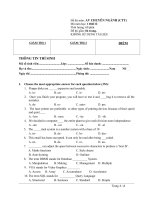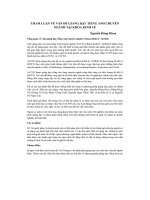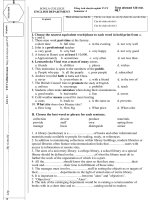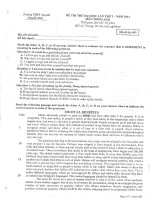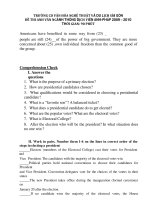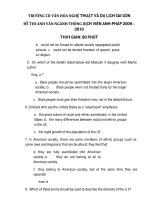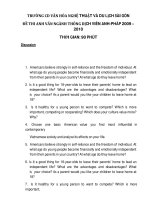de thi anh chuyen nganh
Bạn đang xem bản rút gọn của tài liệu. Xem và tải ngay bản đầy đủ của tài liệu tại đây (48.12 KB, 8 trang )
<span class='text_page_counter'>(1)</span>REVIEW FOR FINAL TEST 1. ..................... is the study of blood. A. Haematology B. Haemophilia C. Haemophobia D. Haemogenesis 2. ...................... is an abnormal tear of blood. A. Haemophobia B. Haemorrhage C. Haemophilia D. Haematoma 3. ...................... which carry oxygen within haemoglobin and give blood its red colour. A. Red blood cells B. White blood cells C. Platelets D. Plasma 4. ...................... that protect against disease. A. White blood cells B. Red blood cells C. Platelets D. Plasma 5. ..................... which help blood clot and seal wounds. A. Platelets B. Red blood cells C. Plasma D. White blood cells 6. Use a syringe to take some blood from a ................ in the patient’s arm. A. vein B. atery C. slide D. pipette 7. Use a ................ to put a drop of blood onto a slide. A. pipette B. test tube C. microscope D. syringe 8. Max Perutz was awarded the Nobel Prize for his discovery of .................... in 1962. A. haemoglobin B. plasma C. human blood groups D. human blood transfusion.
<span class='text_page_counter'>(2)</span> 9. In ................ , Austrian Karl Landsteiner discovered three main human blood groups – A, B and O. A. 1901 B. 1940 C. 1962 D. 1818 10. In 1948, Dr Carl Walter designed ................... for collecting and storing blood. A. plastic bags B. blood bank C. blood group D. blood cells 11. .............. you get pregnant, you put on weight. A. When B. Unless C. What D. Will 12. If you explain the problem to Sister, she ........... (tell) you what to do. A. will tell B. tells C. tell D. is telling 13. You won’t get there on time ................... you hurry. A. unless B. if C. when D. after 14. When you have an anaesthetic, it .............. (stop) you feeling pain. A. stops B. will stop C. stop D. is stopping 15. Pulmonary .................... take blood to the lungs A. arteries B. cells C. veins D. organ 16. Put this slide under the ................. and have a look. A. microscope B. drop C. test tube D. pipette 17. Blood circulates around the body through the ................ system of arteries, veins and caillaries..
<span class='text_page_counter'>(3)</span> A. cardiovascular B. pulmonary C. nervous D. immune 18. More than half of the blood in the body is a fluid called .............. – is mostly water. A. plasma B. cells C. clot D. oxygen 19. If you don’t eat less sugar, you will get .................... when you are older. A. diabetes B. Alzheimer C. constipation D. high blood pressure 20. If blood stops moving, it is a ............. sign. A. bad B. good C. new D. nomal 21. Hair losses .................. and turns grey. A. pigmentation B. impairment C. discoloured D. wrinkled 22. The ................... of the eyes become stiffer and thicker A. lenses B. lids C. wrinkles D. focus 23. Deterioration of the inner ear causes hearing ................ A. impairment B. fragile C. leakage D. sensitivity 24. Teeth become .................... and frigle and fall out. A. discoloured B. wrinkled C. impairment D. leakage 25. Digestion slows down causing ...................... A. constipation B. sensitivity.
<span class='text_page_counter'>(4)</span> C. leakage D. diabetes 26. Fatty deposits restrict the blood flow and cause ....................... A. high blood pressure B. diabetes C. constipation D. Alzheimer 27. The bladder can’t hold as much urine, and there is some .................... A. leakage B. constipation C. impairment D. fragile 28. Insulin is a hormome that controls the level of .............. in the blood A. sugar B. salt C. calcium D. iron 29. It’s very common for ................ people to get diabetes A. obesity B. active C. immobile D. strong 30. It’s very important to eat a healthy ................., containing plenty of fruit and vegetables. A. diet B. snacks C. balance D. glucose 31. I don’t think I .............. (play) sport when I’m 80. A. will play B. play C. plays D. am playing 32. .................... (I/go) out tonight? Er... no, I think I’ll stay at home A. Shall I go B. Will I go C. Do I go D. May I go 33. An elderly person who can’t see very well is .................... A. shortsighted B. forgetful C. immoble D. deaf.
<span class='text_page_counter'>(5)</span> 34. An elderly person who likes to be free is .................... A. independent B. incontinent C. bedridden D. shortsighted 35. An elderly person who cannot leave her bed is .................. A. bedrridden B. incontinent C. independent D. shortsighted 36. The old people who often wet themselves are ..................... A. incontinent B. independent C. shortsighted D. confused 37. The person who can’t hear very well is ................ A. deaf B. immobile C. confused D. forgetful 38. The people who wear their pyjamas wandering in the streets are .................... A. confused B. deaf C. shortsighted D. immobile 39. She is ................... so she needs a power chair A. immobile B. deaf C. shortsighted D. forgetful 40. Alzheimer’s causes a loss of ................... function. A. cognitive B. mobility C. hearing D. stimulation 41. ...................... can be found in fruit, especially citrus fruit like oranges and grapefruit. A. Vitamin C B. Vitamin A C. Vitamin D D. Calcium 42. The B-vitamins keep the ................ healthy and help reduce the stress. A. Nervous system.
<span class='text_page_counter'>(6)</span> B. Immune system C. Digestive system D. Cardiovascular system 43. ...................... can be found in food like wholegrain bread and cereals. A. Vitamin B B. Vitamin C C. Vitamin A D. Omega 3 44. Vitamin A keeps the .................. healthy and is important for good vision. A. Eyes B. Skin C. Muscles D. Organs 45. Vitamin D is needed for healthy ................. because it helps the body absorb calcium. A. Bones and teeth B. Skin and cells C. Muscles and blood D. Brain and organs 46. ...................... is needed for children’s bone and teeth to grow. A. Calcium B. Vitamin A C. Omega 3 D. Zinc 47. If you do not get enough ................, you will be pale and tired and you may get anemia. A. Iron B. Zinc C. Calcium D. Omega 3 48. .................... makes your immune system stronger so that you can fight colds and infections. A. Zinc B. Iron C. Omega 3 D. Calcium 49. Omega 3 is an essential fatty acid which helps your ................. function well. A. Brain B. Organs C. Bones D. Teeth 50. Your muscles, organs and immune system are made up mostly of ....................... A. Protein.
<span class='text_page_counter'>(7)</span> B. Carbonhydrate C. Zinc D. Iron 51. Carbonhydrates are sugar which are broken down by ...................... A. Enzymes B. Glucose C. Blood D. Cells 52. Grain products such as rice, bread and pasta are sources of ...................... A. Carbonhydrates B. Glucose C. Calcium D. Zinc 53. .............. fuel the body and help absorb some vitamins. A. Fats B. Protein C. Carbonhydrates D. Omega 3 54. Unsaturated fats, found in oils and nuts, for example, are believed to protect the ................... A. Cardiovascular system B. Immune system C. Nervous system D. Digestive system 55. The condition of being very fat, in a way that is not healthy is .................. A. Obesity B. Overweight C. Diabetes D. Alzhemer 56. The small amount of food that you eat between meals are .................. A. Snacks B. Lunch C. Dinner D. Breakfast 57. People with diabetes ................. A. Shouldn’t eat large meals B. Should eat large meals C. Should eat too many sweets D. Should put too much salts on their food. 58. People with high blood pressure ............................... A. Shouldn’t put too much salts on their food B. Should put too much salts on their food C. Shouldn’t have breakfast.
<span class='text_page_counter'>(8)</span> D. Shouldn’t get help from the doctors 59. Carbonhydtates are stored in the ................... as a source of energy. A. Cells B. Blood C. Bones D. Muscles 60. A person with an eating disorder should get help from a ..................... A. Psychologist B. Therapist C. Nutritionist D. Mental health nurse.
<span class='text_page_counter'>(9)</span>
